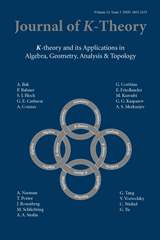Crossref Citations
This article has been cited by the following publications. This list is generated based on data provided by Crossref.
YAGITA, Nobuaki
2016.
CHOW RING AND BP-THEORY OF THE EXTRASPECIAL 2-GROUP OF ORDER 32.
Kyushu Journal of Mathematics,
Vol. 70,
Issue. 2,
p.
227.
Bakuradze, Malkhaz
2017.
Polynomial behavior of the Honda formal group law.
Journal of Homotopy and Related Structures,
Vol. 12,
Issue. 2,
p.
299.
Bakuradze, Malkhaz
and
Gachechiladze, Natia
2017.
Some $2$-groups from the view of Hilbert-Poincaré polynomials of $K(2)^*(BG)$.
Tbilisi Mathematical Journal,
Vol. 10,
Issue. 2,
Hutchinson, Samuel M A
Marsh, Samuel J
and
Strickland, Neil P
2022.
Chromatic (co)homology of finite general linear groups.
Algebraic & Geometric Topology,
Vol. 22,
Issue. 4,
p.
1511.
Bakuradze, Malkhaz
2025.
Morava K-theory rings for finite groups.
Journal of Homotopy and Related Structures,
Vol. 20,
Issue. 4,
p.
567.

